Bangor Northern Ireland to The Isles of Scilly
Unfamiliar waters for us always hold a tasty mixture of adventure and challenge, to be met with due research, experience and caution. Our outward journey last year took us across from The Isles of Scilly to Baltimore in the south west Irish Republic, so on this next leg we will cross our outward journey and thus have circumnavigated Ireland, to include a fair bit of Scotland to boot; calls for a celebration ashore in Hugh Town methinks, but firstly a little confession.
When Rob lifted the anchor in Larne, by Island Magee, (love that name) before our 17-mile trip around to Bangor Marina, the flukes came up clean with a scarf of kelp, so either it was dug in to a mixture of mud and sand which cleaned the anchor on extraction or maybe we had been held fast on the sinker of a yellow buoy that the chart showed was once in the area. Undoubtedly there was mud around because we saw it later from the far end near Ballycarry. Whatever Zoonie held on to it gripped us nice and tight for the duration.
Motoring south to the next stop Rob noticed a walkway just above sea level, clinging on to the cliff face and occasionally disappearing into the rock surface, while he was lowering our fraying Scottish courtesy flag. The Gobbins was first designed and built in 1902 by the Chief Engineer of the Belfast and Northern Counties Railway Company, Berkeley Deane Wise and became an instant global success from its opening ceremony, and went on to our list of things to do around Belfast. (Should be called Goblins, I thought). But more about that delightful adventure in a later blog.
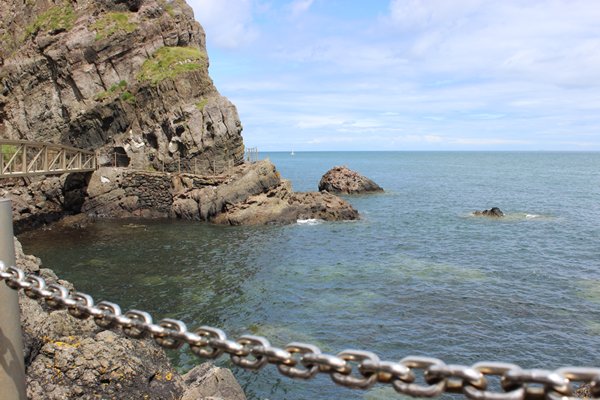
Bangor Marina is one of the yacht venues owned by the Boatfolk Group and Zoonie will be homed in their Marina in Portland when we get back from this voyage. So, we asked if we could use some of our allowance of gratis days in their other locations that will be valid from the start of our contract in August, while we were here. Graciously the manager Keith agreed to this, which put our new relationship with the group onto a stable footing.
Friendly smiling people all around, resident, tame guillemots that rested beside the main walkway ashore, smart and clean facilities with vases of lilies, and an excellent chandlery that stocked two obscure items we needed for Zoonie makes this an excellent place to stay. There is easy 30-minute train access along a pleasant commuter belt to Belfast and it is virtually half way between Stornoway and The Scillies. We left Stornoway on the 4th July and with two stops to sit out strong headwinds, we arrived here in the Scilly Isles 16 days later. The sea time involved makes another cruise in the western isles a possibility for some time in the future.
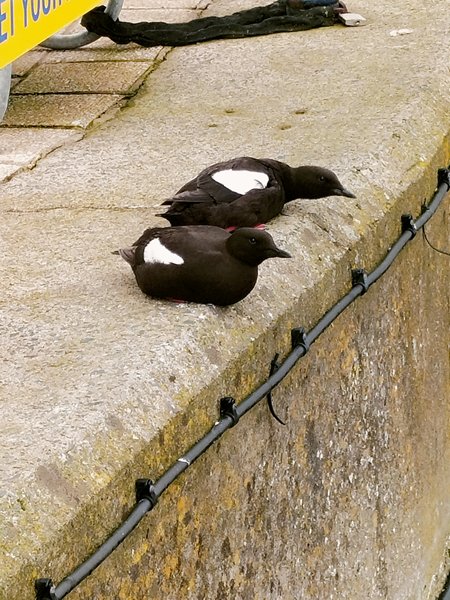
We stayed in the Marina for five nights and in that time visited the Titanic Exhibition and the Monet Immersion Experience, rode the streets of the city on a tour bus, felt the chill of a prisoner’s life in the Crumlin Road Gaol and had a good look around the once fashionable seaside resort of Bangor which has become a pleasant, commuter place to live not too far away from the big city. I’ll go into more detail later, but for now, how was our non-stop passage to St Mary’s Pool in the Scilly Islands?
As usual we awaited a weather window that would let us do the passage in one, and we didn’t have to wait long. There are few stop-overs for the likes of us on the Irish side of the Irish Sea, and with the chance that kelp would again make anchoring impossible for us, we might have had to continue onwards anyway. We did not want to go too far east with the prevailing winds being South Westerly, this would make reaching back to pass the Lizard Peninsula an uphill task.
We set our sights on the Scilly Islands because Falmouth raises issues of available space and high prices, even for anchoring, and the Scilly Isles would give us a good position to sail directly to Portland. Weather windows are short and the season marches on. Having been to this mooring field before we know the buoys, that are attached to a substantial chain matrix on the sea-bed, are designed to keep vessels secure in a gale, and strong winds were expected for the weekend. Indeed, Zoonie and the rest of us are rocking, on double mooring lines, in those winds at the moment. (Saturday 22nd July)
So, to the 51 hours passage.
The sea state was confused as the mass of water jostled to squeeze through the North Channel between North East Ireland and The Mull of Kintyre. I had made a mistake with the tides, reading the Low Tide time for High Tide, but as we were heading away from the North Channel and our passage would traverse numerous tides, it didn’t matter and Zoonie motored gently against it, knowing we’d make up the set-back when it turned, with a speed of 8.3 knots at times with the ebbing tide.
Lights of ships between Liverpool and Dublin gave us something to watch during the night hours and during the day the temperature was definitely getting warmer so we could shed our second layer of fleece by midday. Summer temperatures at last!
Under a bright sunny sky, the sea-state changed to one more familiar to us and with her white sails pulling well we could imagine we were back on the Pacific Ocean, if it wasn’t for the faint outline of Ireland to the west. It was grand to be ‘at sea’ once more.
I was a little perturbed when I called up one ship to ask which side of us, he intended to pass, to be told we didn’t appear on his radar, but as soon a we did he would steer clear of us. Reassuring!
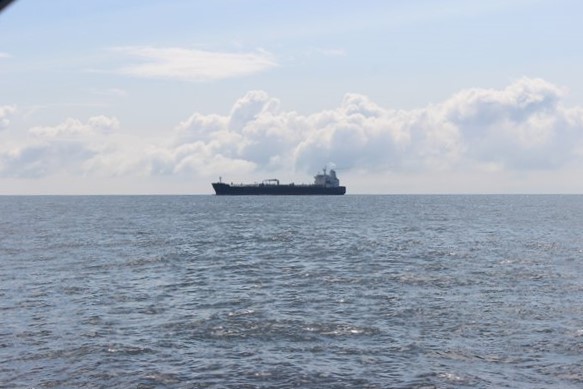
Talking of radar, how do guillemots find each other to roost in big groups? Do they use radar, or eyesight, or their knowledge of the area, I wonder?
Entering St George’s Channel between St David’s Head, Wales and Waterford, south east Ireland, the sea state became familiar once more; the Irish Sea was behind us and the Celtic Sea lay beyond. The engine was on again as the wind dropped and headed us, but never mind, we were heading directly for the Isles, guillemots were seeking somewhere for their wet roost and Zoonie was rising to the gentle Atlantic swell. It was wonderful being homeward bound.
The evening sunset was a treat..

On our last morning, as usual hereabouts, dolphins came from all directions in small pods and played around, before swimming on to join the gannets, fishing. The pagan reassurance of another day came from a golden sky….
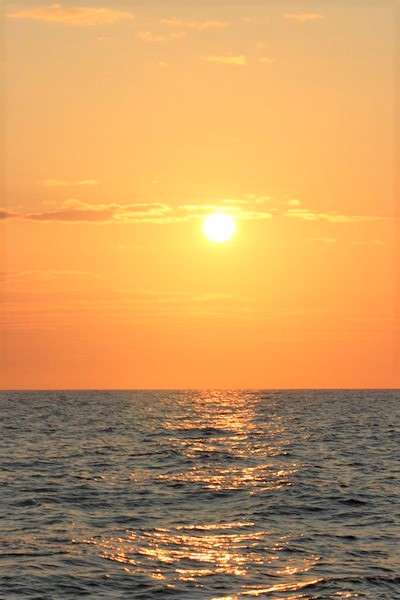
And the dolphins and gannets were not the only ones fishing….
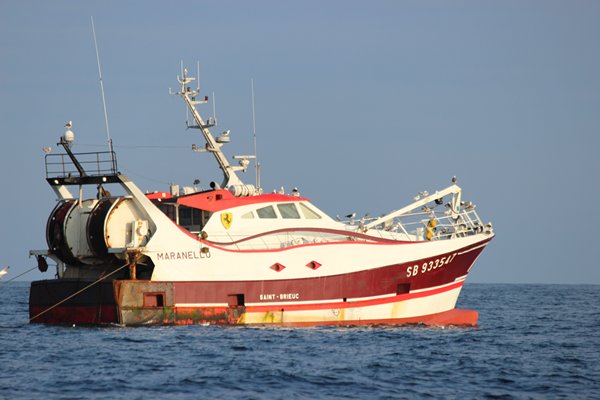
Some essential boat work before our arrival in The Scilly Isles…
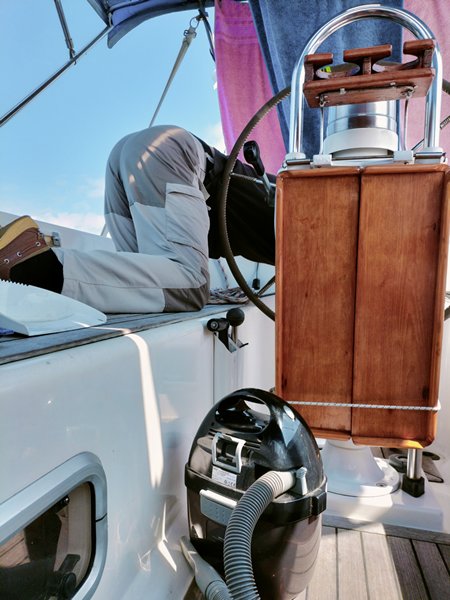
(Writing from Zoonie’s new berth; L4 in Portland Marina having beaten the latest blast from the west by a mere couple of hours.)
We spent five days in the Scilly Isles awaiting a window and watching the comings and goings in the conversely exposed and yet safe mooring field.
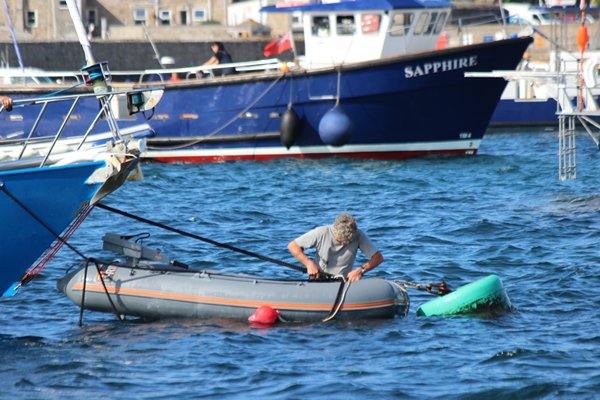
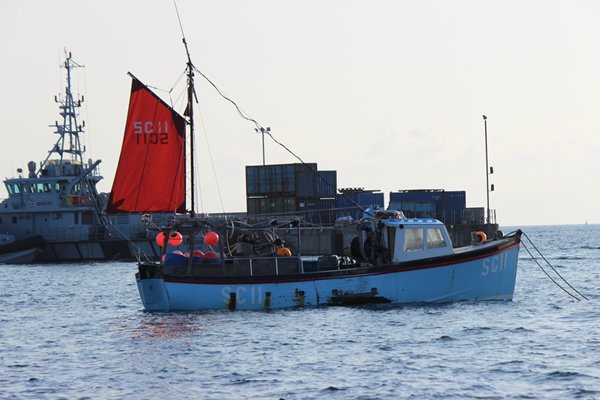
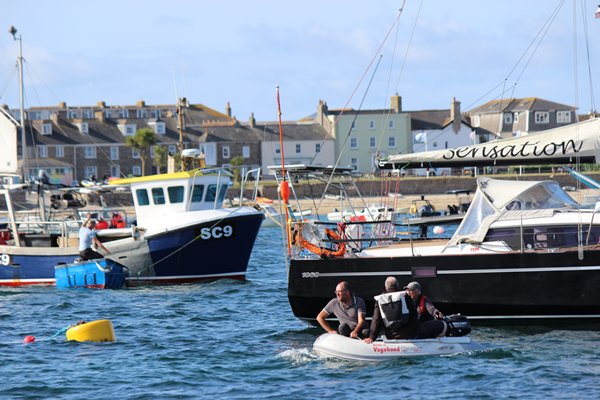

The local dinghies enjoyed a lovely evening of sailing….
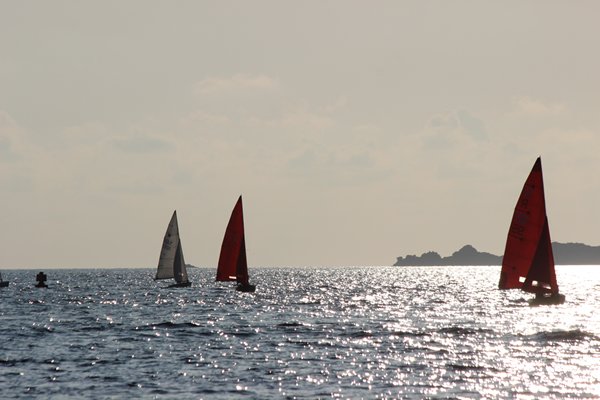
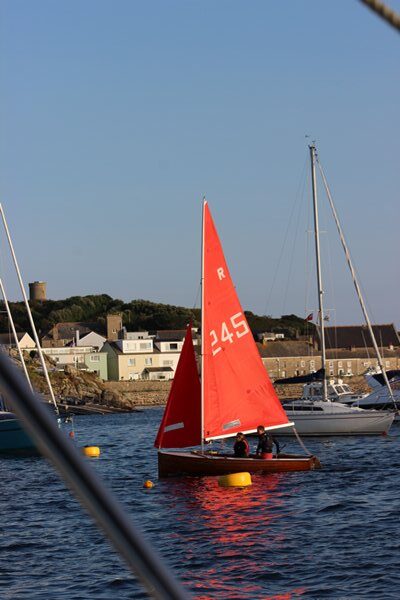
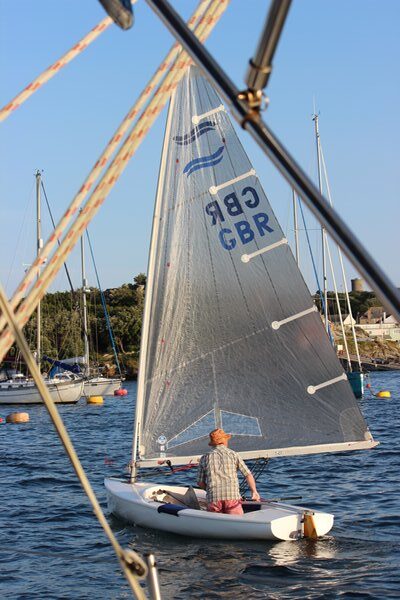
I was not bothered about going ashore in the inclement weather but we did manage a short walk and pub lunch before the first blow arrived.
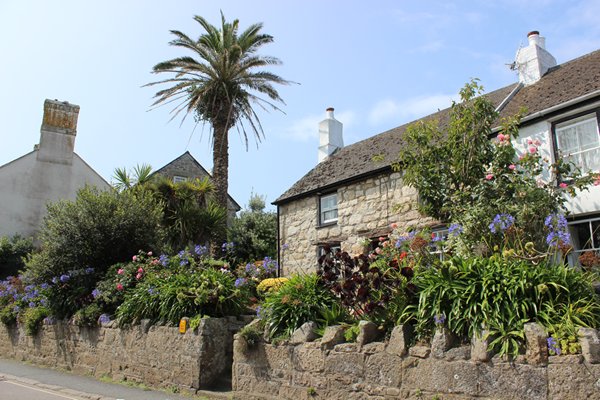
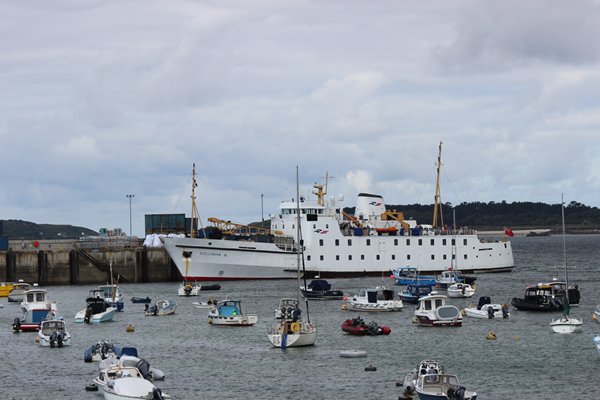
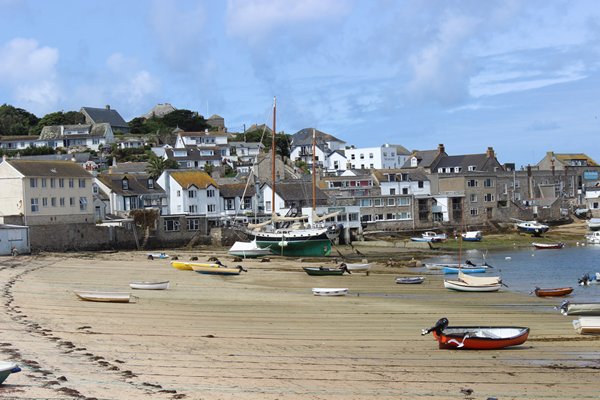
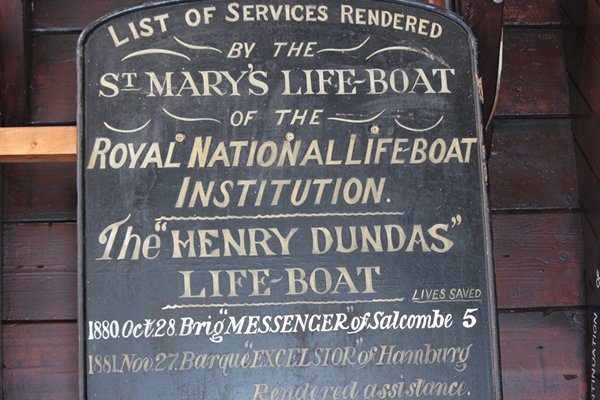
At the lifeboat station the record of rescues painted on black boards and suspended around the ceiling tell off the changing nature of the role of the RNLI, from servicing commercial sailing boats, to leisure craft and modern motorised cargo carriers. Do you remember the wreck of the Torrey Canyon in 1967?
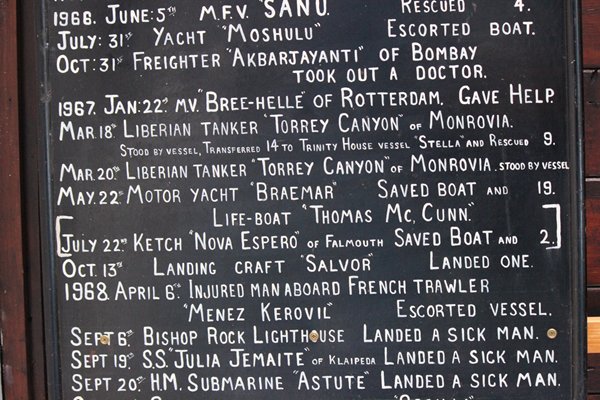
That changed the way oil tankers were built. She shed her load of 25 -36 million gallons of crude oil over one thousand square kilometres, oil that is now buried deep beneath the sand after nature’s clearing up process. Double skinned tankers and shipping separation lanes have served to make oil transportation much safer since then.
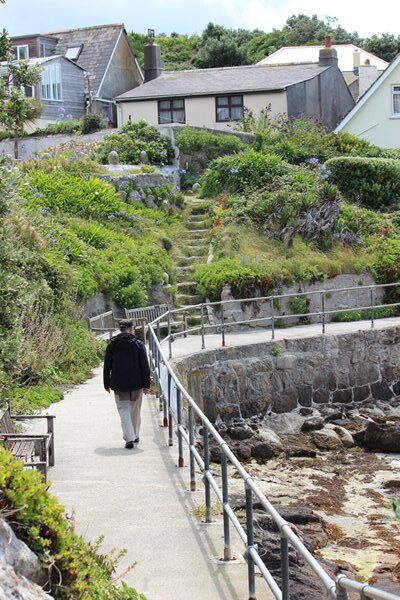
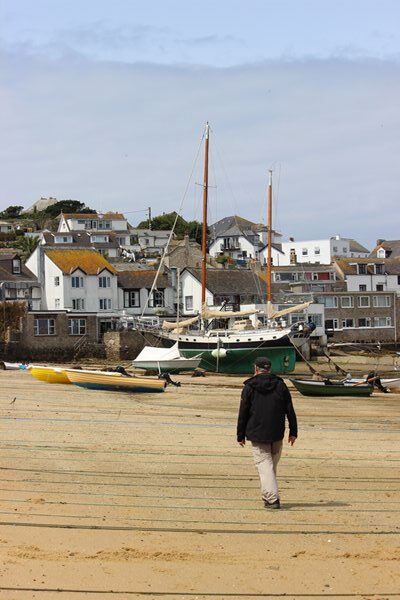
See how this lovely ketch is actually sitting on her keel, and not her legs. She’s been there for years and is well maintained. Looks as if she came from the east methinks.
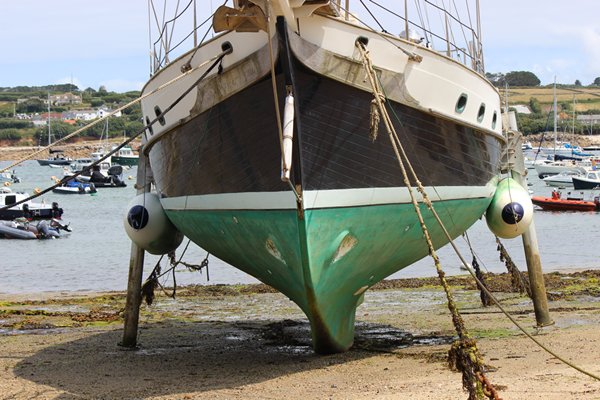
The mooring buoys rise up from a substantial matrix of heavy chain lying on the sea bed in St Mary’s Pool, Hugh Town, and when we arrived we picked up one, with some kind help from a neighbouring crew man in his inflatable dinghy because the little pick-up buoy had wrapped itself around the big green buoy. We chose this colour because there is more room around them and they are designed for 40 foot plus yachts. With the windy weather on its way and because the moored motor boats swing differently to us sailing yachts with our deep keels, we decided space was in direct proportion to peace of mind.
A Frenchman arrived on a sailing boat with six crew after a hairy 20 hour run across from Brest, and having got safely into the mooring field slowed down under engine to the extent his yacht was drifting towards the rocks. He tried numerous times to bring her to the buoy but just didn’t seem able to get her in the proximity to enable his crew to pick up the line that one of the Harbour guys on his rib was holding for them. Finally, the Harbour master spun the rib round to the side of the yacht, clipped it on, leaped aboard and took the helm, (and I wondered how easy that was, he appeared to get no resistance from the Frenchman!!) and in moments the competent crew were able to hook the pick-up line and with help from more crew and the Harbour man, they brought the heavy chain on board so a line could be threaded through the link and made fast.
The skipper must have been so exhausted and maybe hadn’t slept for those 20 hours. An example of how exhaustion can negatively affect one’s judgement. Other yachtsmen, us included, watched until all were safe and sound. We could not help as our dinghy would almost certainly have capsized in the turbulent waters, creating another potential disaster for the already hard worked harbour crew to deal with.
We were intending to start our passage up the channel last Monday but the sting in the tail of the low-pressure system arrived later and lasted longer so we sat tight for another 24 hours. During that time two yachts arrived while the wind was still howling and had difficulties picking up mooring that were near us. I wondered why they didn’t try bringing the buoy alongside the cockpit where the distance to the water is less, and then that’s exactly what one couple tried to do.
The wife took a line from the bow to the stern, hooked the pickup buoy perfectly, got the long line through the chain link and was walking it briskly forward when her husband inexplicably gunned the engine forward and she had to let go the line quickly, to avoid being pulled overboard or losing the line into the water. They disappeared out again and anchored in a little bay the other side of St Mary’s.
I can ‘talk’ about this now that we are safe in Portland. I could have written more blogs while we were in the Scilly Isles but my mind was in an uncomfortable place. Over my adult life I have read and heard about so many sailing vessels coming to grief on their final leg home, that I was concerned for Zoonie. We would be applying exactly the same dual-minded approach to the passage that would take nothing for granted and would be as respectful of the sea and elements as ever, but even so??????
One of my strongest fears was having to motor in the hours of darkness and Zoonie getting caught on a pot, the hefty rope twisting around her spinning prop and leading to all kinds of possible problems, the worst of which would be losing her. So, I decided it was time to apply a little common sense to the matter. Pots are only laid over rocks to capture the crustaceans that live there. So, wherever the sea-bed was smooth sand there would be no pots. Wherever our charts, paper and digital, showed a shallower area, there was likely to be a rocky area and therefore pots, at which time we might have to shine a torch forward.
So, with that logic in mind, we set off just after 5.00am on Tuesday and soon had the Diva (mixed blue coloured cruising chute, veteran of our circumnavigation) pulling us across towards The Lizard, the water hissing by us like lemonade escaping. The Sail Training Ship Thalassa looked fine as she made her way south westwards. All was mighty well in our little world.
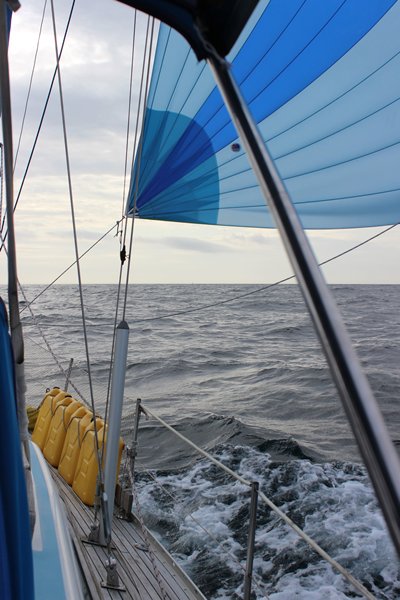
The Thalassa as she passed Lands End and Wolf Rock Lighthouse…
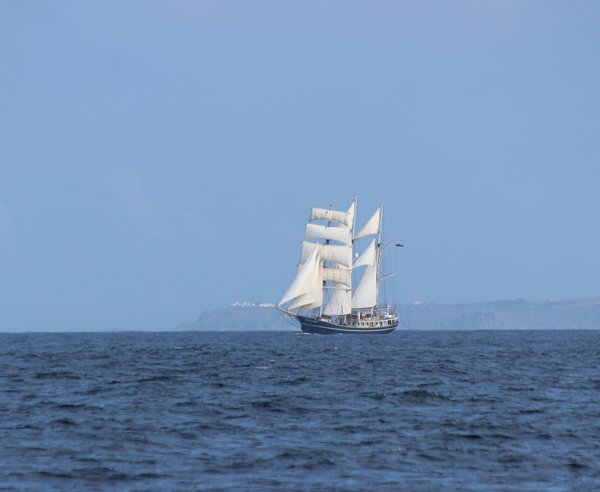
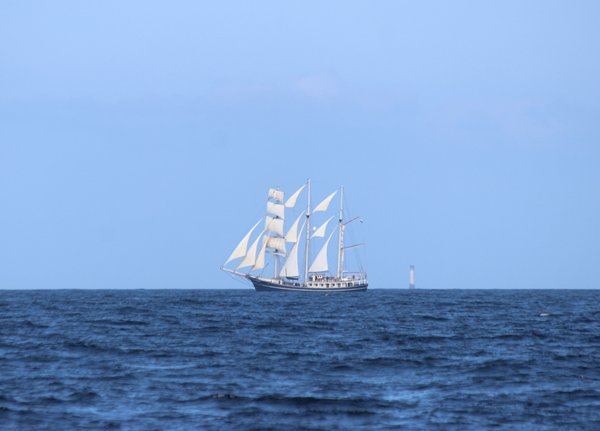
I was watching the depth display rise from 74 metres to the 50’s and yes there were some pots, but during daylight.
The Diva was on stage for twelve hours, more than one third of the expected time of the passage, and that was very satisfying.
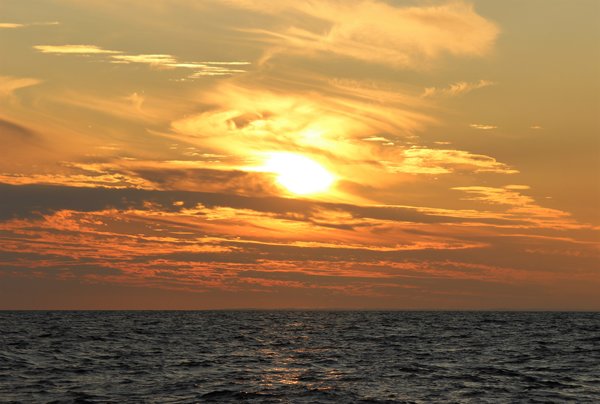
But then we had to motor that night and it would be dark from just after nine until around 4.30am. Looking at Zoonie’s track the seabed remained a nice constant 70 metres and we powered on towards Start Point with dolphins playing around us the whole way. One would dive beneath her keel and shoot up the other side, out of the water and splash as loudly as possible back into the blue abyss. Lovely to watch, these friendly beauties. On Zoonie’s port side her red port hand navigation light shone on their watery bodies as they whizzed around, and while they emerged from the water it shone a lurid redness on their smooth shiny skin.
Lyme Bay lay ahead of Zoonie’s bows and there was a marked area just a few metres shallower than the shelving sea-bed. So, in daylight we watched four pot buoys and their buoyed pickup lines pass by a safe distance away. My theory seemed to be paying off.
The wind was light but we could see the weather system approaching from the west as the grey/purple sky slowly followed us towards Portland Bill.
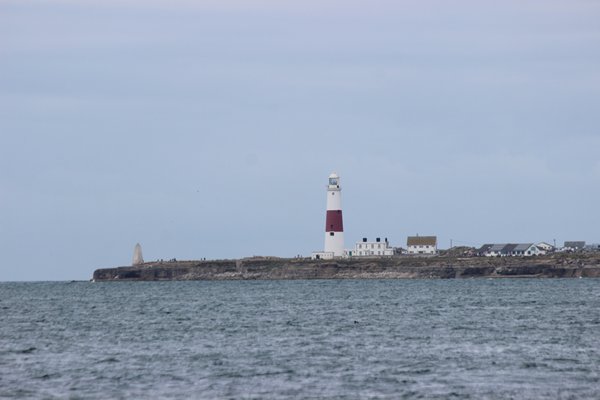
We turned into the harbour to face the rising wind, past the incongruous mixture of moored vessels including a cruise liner and the Bibby Stockholm barge, to be home to 500 immigrants over the next 18 months, to find a willing pair of hands ready to take Zoonie’s lines in Portland Marina.
So that is the end to our two-year cruise to Scotland and back and now it’s time to take stock and organise our new lives; having Zoonie within an hour of our land home for the first time since we bought her in 2011 and all the choices that brings us. I will post blogs about our fascinating exploration of the Outer Hebridean Islands of Lewis and Harris and our time in Bangor over the next weeks, but as for sailing, well that is all for a little while dear readers.